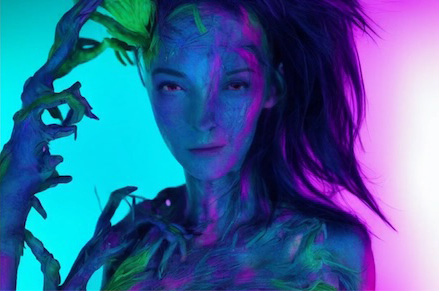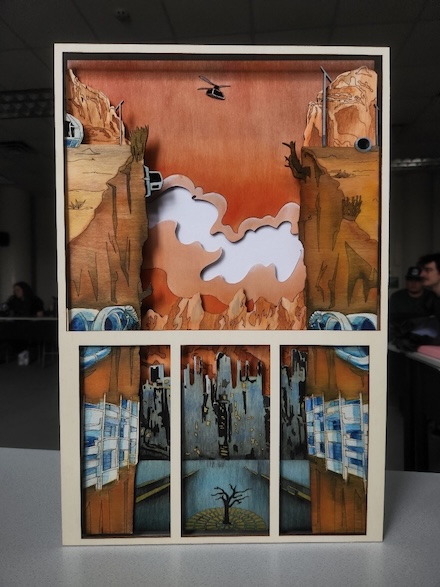At Ohio University, faculty member Basil Masri Zada has dedicated the past several years to helping develop the coursework for the new concentration in the School of Art and Design, Digital Arts + Technology. This area of study focuses on the constantly developing relationship between technology and art and allows students to develop their own approaches to creating art in an increasingly digital age.
Two of the main courses within the curriculum, ART 2110 Digital Art + Technology I and ART 3110 Digital Art + Technology II, place specific emphasis on deploying artificial intelligence (AI) as a creative tool to produce diverse forms of artistic expression. Throughout the courses Masri Zada’s students use the software Stable Diffusion Automatic 1111, a popular open-source generative AI tool, to inspire, edit and enhance their artwork.
Before launching the course in 2023, Masri Zada worked with the Ohio Department of Higher Education’s Ohio Supercomputer Center (OSC) to host a version of the Stable Diffusion software on OSC machines. This allows students to easily access the software on any device through OSC’s remote access platform OnDemand and offers them privacy and control over the data they generate.
“I originally reached out to OSC because I needed to be able give our students who don't have powerful computers access to the Stable Diffusion technology to remotely create work individually and collectively as a class, while having a protected environment,” said Masri Zada, assistant professor of instruction, digital art + technology.

In the last few years AI usage has surged across various industries. Its expanding presence in the art world, however, has raised questions about authenticity, copyright and representation. Some of Masri Zada’s students, for example, initially were resistant to the idea of utilizing AI to create art, due to such concerns.
Much of the training material used to teach text-to-image AI today comes from the public domain that includes news and information, and as a result can inherit any biases present in those materials, Masri Zada said.
Masri Zada learned about this issue through his personal art practice, which touches on the conflict ongoing in his native Syria.
“My first experimentation with AI in my own practice involved trying to showcase the faulty data that AI is trained upon,” Masri Zada said. “Feeding certain AI programs prompts relating to Syria, different races, cultures and backgrounds often generated stereotyped results. It is part of my practice as an international artist and scholar to try to show the biases in these databases and explore how we could create more inclusive AI.”
Utilizing Stable Diffusion hosted on OSC resources, Masri Zada and his students access their own isolated version of the software, which allows them to explore the impact of training materials on the behavior of AI and to understand biases present in existing training data.
Masri Zada also chose Stable Diffusion because of the level of control it gives the artist. Unlike many other generative AI software programs available, Stable Diffusion goes beyond text-to-image prompts and allows for precise editing within the image called “inpainting.” This heightened level of control turns the software into a valuable tool that artists can seamlessly integrate into their creative workflow, rather than it being the sole generator of artistic output, Masri Zada said.
By enabling the class to explore the burgeoning technology without fearing the uncertainty or stigma often associated with AI, students could assess AI as a tool and determine how it fits within their creative processes.

“OSC brought equity and accessibility to my students, allowing them to use top-of-the-line technologies in a safe environment from any device,” Masri Zada said. “This access transformed a lot of students’ practices as they started to use different processes and create different work. Students created work that was amazing and would not have been possible without this technology.”
“The AI model improved the workflow of my creative work during multiple projects during the past semester,” said Addie Smith, a student who participated in Masri Zada’s class. “I've tried using Stable Diffusion on my computer previously and had many issues, so accessing it on OSC improved the speed and allowed for more customization within animated sequences using our database.”
Masri Zada has implemented this use of AI within four classes over the past two semesters. This spring Creative Coding for Artists I and Creative Coding for Artists II will also incorporate AI. Moving forward, he aims to continue using OSC resources to broaden the projects by incorporating more training data sets and enhancing the software with additional functionality. Throughout this expansion, he will remain committed to maintaining unbiased training materials.
“I believe this will be a continuous project,” Masri Zada said. “Anything we accomplish collectively will be implemented for the next semester and the course will grow. Stable Diffusion and AI keep growing, and the students and I will grow alongside it.”
Written by Kiah Easton
About OSC: The Ohio Supercomputer Center (OSC) addresses the rising computational demands of academic and industrial research communities by providing a robust shared infrastructure and proven expertise in advanced modeling, simulation and analysis. OSC empowers scientists with the services essential to making extraordinary discoveries and innovations, partners with businesses and industry to leverage computational science as a competitive force in the global knowledge economy and leads efforts to equip the workforce with the key technology skills required for 21st century jobs.